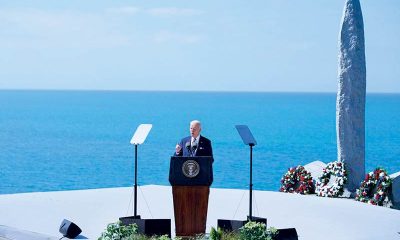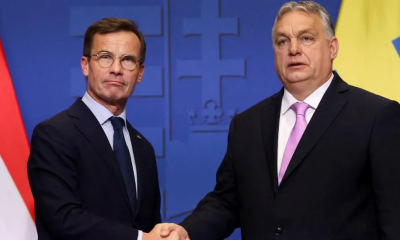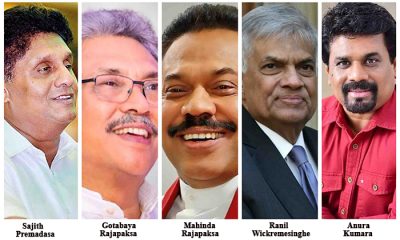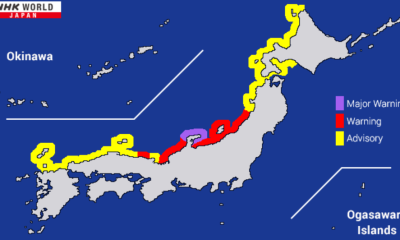Features
NEVER SURRENDER – AGAIN EXPOSING FAKE NEWS

by Vijaya Chandrasoma
One of the most humiliating weeks in American history ended last week, with the fake news media covering, almost exclusively, the arrest of former President Donald J. Trump at the Fulton County Jail on Thursday, August 24.
No former president had been arrested on criminal charges in the history of the United States. This arrest of President Trump, and the others in Manhattan, Washington D.C. and Miami, had only been carried out to shame the greatest President since Abraham Lincoln, a continuation of a seven-year-long witch hunt. An insidious conspiracy by the Deep State, led by George Soros, the New York billionaire who hates Republicans.
During his first term, President Trump had carved, out of the terrible economic mess left by the illegal administration of the “Muslim Kenyan” Hussein Obama, the greatest economy the world has ever seen, in spite of a global pandemic. President Trump never doubted that Obama was born a Muslim in Kenya, which he announced repeatedly at his campaign rallies, even though Obama had produced the long-form birth certificate that he was born in Hawaii.
One of his greatest achievements was bringing our people together. He has proved himself to be the least racist president ever. During the race riots in Charlottesville, VA in 2017, he showed his impartiality and tact when he said, “there were very fine people, on both sides”, referring to the patriots who were exercising their First Amendment rights, chanting, most peacefully, “the Jews will never replace us”, and the Zionist war-mongers attacking them.
We will never forget how President Trump sprang to the aid of Puerto Rico, after it was hit by Hurricane Maria, one of the worst disasters in its history. He visited the island, even though, as he said, “it was surrounded by water, big water, ocean water”. He eased the suffering of the hurricane-hit Puerto Ricans by lobbing paper towels to them at a press conference, which were received with tearful gratitude.
After his outstanding first term performance, the American people overwhelmingly elected Trump for a second term in November 2020. His win was announced on election night, but by the next morning, his own elections officials, weaponized by Biden, had stolen the landslide that was his 2020 presidential victory. President Trump will never concede that he lost this election because he was cheated of it. Neither will we. In our minds, he remains the 46th President of the United States.
Because of this stolen election, the USA is now the joke of the world. Sleepy Joe’s withdrawal from Afghanistan, without any exit strategy, was the worst military decision in history, one that cost us billions of dollars and thousands of precious American lives.
The economy is near recession, inflation out of control, crime at its highest levels and Biden’s foreign policy decisions are threatening the security of the nation and its citizens.
Biden is trying to ingratiate himself with our so-called NATO allies, who have been a huge financial burden for decades. They haven’t been paying their fair share for their own defense. President Trump will withdraw immediately from NATO when he is elected president in 2024. He will never again engage in meaningless wars unless they are in the best interests of the United States. When he is back in the White House, it will always be America First.
He will also give notice of America’s withdrawal from the toothless United Nations Organization, which has proved to be a complete failure. Like NATO, we are sick of financially carrying those shithole, third world countries, who refuse to pay their outstanding UN dues.
President Trump will resume the relationships he had been carefully nurturing during his administration with the Superpowers that matter in the world today. He has always had a very cordial relationship with President Putin, a strong but compassionate leader. Had he been the president, the Ukraine war would never have got off the ground. He would have persuaded Zelensky to submit to Russia, Ukraine being an integral part of Russia. Maybe the annexation of Ukraine would have encouraged Putin to invade other countries of Europe, but that is not our problem. The Europeans have brought these ethnic divisions amongst themselves by mollycoddling Jews and encouraging immigrants from their erstwhile colonies.
President Trump will never get America involved and throw billions of dollars in these European internecine wars, especially because we may never know if we are backing the right horse.
Biden has antagonized not only Putin but also President Kim of North Korea, with whom he had not just cordial relations, but a love affair. And President Xi of China was literally eating out of his hand. All these fine relationships ruined by Senile Joe’s misguided policies.
There is every chance that our Congress will impeach Biden before November 2024 for making millions of dollars, in collusion with his drug addict son, Hunter, from Ukrainian and Chinese companies. These crimes are real, unlike the 91 phony felony charges alleged to have been committed by him. President Trump’s innocence of all these false charges will be proved after he wins the presidency in 2024, when he will pardon himself or get his Attorney General to dismiss them.
How we miss the beauty of Melania, and the incorruptibility of his children, especially Ivanka and Jared, who helped consolidate our relationships with China and Saudi Arabia. They all brought a touch of integrity and class to the primitive White House we inherited from Hussein Obama. Thank God the Trumps will be back where they belong soon.
President Trump is the prohibitive favorite for the Republican nomination for the 2024 presidency. Even the Republicans who are running against him support him. After all, who else is there, in either party? Just a bunch of sycophants, demented octogenarians, commies and poofters. Donald Trump, convicted felon or not, is our only patriotic choice for four more years, maybe longer, when he will be able to complete the job he started in 2016.
The corrupt District County Attorney of Fulton County, Georgia, Fani Willis is attempting to criminalize his polite request to the Georgia Secretary of State to “find” 11,780 votes in the 2020 election. A request is not a crime, it is covered by the First Amendment. In any event, we all know Trump won Georgia by hundreds of thousands of votes. President Trump was being more than modest when he asked Rafffensperger to find only 11,780 votes, one more than the 11,779 votes that gave the state fraudulently to Biden. Raffensperger could have found 111,780 votes, had he looked in the right places. He is a traitor, just another RINO (Republican In Name Only).
And the Department of Justice, weaponized by Biden, has alleged that he stole top-secret documents when he left the White House. He only removed these, which in any case belonged to him and were declassified telepathically by him, to keep them out of the crooked hands of the Biden crime family. They would surely have sold these documents to the Chinese.
Another blasphemous rumor is being floated by the fake media: that many so-called “distinguished constitutional lawyers, from the right and left” contend that, according to Section 3 of the 14th Amendment of the Constitution, President Trump, by virtue of “his incitement of an insurrection and having given aid to the enemies of the United States”, has disqualified himself from running for any future public office. A pure Constitutional delusion.
They are falsely alleging that he was involved in the insurrection on January 6, 2021. On that very pleasant day, President Trump requested his supporters to protest the stolen election peacefully at the Capitol, and to plead with Vice-President Pence to postpone the fraudulent Electoral College count submitted by the states. They did their peaceful best, but the cowardly Pence refused, citing a false interpretation of the Constitution, thereby handing over the presidency to Biden.
The President then told them to go home, “that he loves them, they are very special”. He is convinced, even today, that those patriots who visited the Capitol that day, went there as tourists, to peacefully protest the unlawful transfer of power. How can such patriotic behavior ever be construed as “giving aid to the enemies of the United States?”
Even during his arrest in Atlanta last week, Biden’s law enforcement authorities were maliciously skeptical about the personal details Trump had submitted, that he was 6 ft. 3 ins. tall and weighed 215 lbs., exactly the same statistics as the great Muhammad Ali at the peak of his boxing career. Anyone who has seen photographs of the athletic Trump playing tennis will have no doubt about the veracity of this comparison. Actually, except for differences in skin colors, Ali’s a light caramel compared to Trump’s beautiful orange, they show a striking resemblance in their magnificent physiques.
The real action was in the marketplace, where Trump memorabilia emerged within hours of his arrest. Although the fake media contrived to depict his arrest in a bad light, we consider this, his fourth arrest, a badge of honor, actually the Grand Slam of badges, if you will, achieved as they were in four different venues.
The Trump SAVE AMERICA Campaign launched the sale of various items: T- Shirts, posters, beer mugs, etc. with Trump’s mug shot, and the words NEVER SURRENDER printed boldly below, hours after he had surrendered at Fulton County Jail. We have, in the first few days, collected over $9 million from our devoted supporters from the sale of Trump merchandise.
Trump’s mug shot is the most photographed picture in history, one that schoolboys will admire in their history books in 300 and more years from now. This stuff will be worth their weight in gold in due time. We have to help our leader, he is so innocent that he said after his release from jail, “I don’t even know what a mug shot is. They didn’t teach me anything about mug shots and indictments at the Wharton College of Finance”, where he ended his academic career at the top of his class, with a Summa Cum Laude Masters’ degree in business management.
The partisan, unwarranted hostility, even by RINOs, shown against the greatest president in the nation’s history, cannot be better illustrated than by a comment made last week by Republican traitor, Lt. Governor of Georgia, Jeff Duncan. He said that President Trump has the moral compass that would be the envy of an axe murderer.
This is the kind of maleficent hatred with which we are forced to contend. But contend we will. President Trump will be triumphant in the 2024 presidential election in a landslide. And he promised in an interview with rightwing broadcaster Glenn Beck last Tuesday, that he “will lock up his political opponents if he returns to the White House”.
Should the Democrats once again deny President Trump his rightful victory by rigging the 2024 elections, then we will be ready, we will be standing by. We will never let the commies imprison our President Trump. To quote the President, “I am the most innocent man in history. I have never done anything wrong in my life. As God is my witness”. Brace yourselves, we are no longer playing games.
Features
Putin in Modi’s India

That was no ordinary greeting; on the frosty evening of last Thursday, Indian Prime Minister Modi embraced Russian President Vladimir Putin in a bear hug at Delhi airport and, within moments, presented him with a copy of the Bhagavad Gita in Russian. The choice of gift was laden with symbolism—echoes of Robert Oppenheimer, who drew profound philosophical reckoning from the same text, declaring, “Now I am become Death, the destroyer of worlds,” after witnessing the first atomic explosion. Was Modi signaling the weight of nuclear-age responsibility to Putin, or was this a deliberate affirmation of India’s comfort in maintaining ties with a pariah state under global sanctions?
The streets of Delhi, festooned with Russian and Indian flags and dominated by colossal billboards of Modi and Putin, suggested more than ceremonial protocol—it was pageantry of influence, an audacious statement of India’s strategic independence. In that gesture, New Delhi appeared to assert that moral judgment from the West would no longer dictate its choices, and that the Indo-Russian relationship, forged during the Cold War and hardened by decades of defence dependence, remains a pivot capable of unsettling the established order in South Asia and beyond.
Putin’s first visit to India in four years, coinciding with talks in Washington over a possible Ukraine peace framework, came at a time when New Delhi is walking an increasingly delicate tightrope between Moscow and Washington. The optics of the visit—from ceremonial receptions at Rashtrapati Bhavan to summit talks at Hyderabad House—reflected not merely diplomacy but an overt projection of influence. Modi’s presentation of the Bhagavad Gita in Russian was emblematic: a centuries-old text of dharma and duty, layered with the moral weight of choice, now inserted into the theatre of high-stakes realpolitik.
Putin himself, in an interview with India Today, described India as a “major global player, not a British colony,” praising Modi as a “reliable person” who does not succumb to pressure. These words, spoken against the backdrop of US sanctions, EU manoeuvres to leverage frozen Russian assets for Ukraine, and growing Chinese assertiveness, highlight India’s determination to claim agency in a multipolar world where Washington and Brussels no longer set the rules unilaterally.
Historically, the Indo-Russian relationship has oscillated between strategic necessity and opportunism. Declassified CIA documents from the 1980s reveal the delicate dance India played with the USSR during the Cold War. Indira Gandhi’s approach, as the CIA observed, was staunchly nationalist and fiercely protective of India’s regional supremacy. The United States feared that India’s policies towards its neighbours, coupled with its Soviet alignment, could destabilize South Asia while simultaneously granting Moscow a strategic foothold. Today, the echoes of that era reverberate: New Delhi remains Moscow’s top arms buyer, leases nuclear-powered submarines, and maintains energy ties that have drawn ire from Washington, while ensuring that its engagement with Russia does not fully alienate the United States or Western partners.
What is important to see here is the economic metrics. India-Russia trade in 2025 is estimated at roughly $18 billion, heavily skewed in Moscow’s favour due to energy imports, while India continues to negotiate with the United States to mitigate punitive tariffs, including a 25 percent secondary tariff imposed over India’s purchases of Russian oil. Both nations aim to expand bilateral trade to a target of $100 billion by 2030, a goal that falls just two years after the next general elections, when Prime Minister Modi is widely expected to contest again despite the symbolic 75-year age limit for party leadership—a restriction that has largely been treated as political theatre and quickly forgotten. It is worth noting that India’s trade deficit with the US has ballooned to approximately $42 billion in the last fiscal year, reflecting both structural imbalances and the impact of these punitive measures. Remittances provide a partial counterweight: Indians working in the US send home over $90 billion annually, dwarfing Russian remittances, which are negligible in comparison. This indicates that while India faces challenges in trade metrics, its diaspora injects substantial financial resilience into the economy.
The summit also highlighted defence collaboration in stark terms. India’s $2 billion lease of a Russian nuclear-powered attack submarine, with delivery scheduled for 2028, signals an unprecedented deepening of underwater capabilities. The vessel, unable to enter combat under lease terms, is intended to train crews and refine India’s nuclear submarine operations—a critical step for strategic deterrence in the Indian Ocean amid rising Chinese and US naval competition. Russia, despite sanctions and Western pressure, continues to sustain a military-industrial complex capable of producing tanks, missiles, and drones at accelerating rates. As reports from Ukraine’s Center for Analytical Studies and Countering Hybrid Threats indicate, nearly half of Russian defence enterprises remain unsanctioned, exposing the limitations of Western punitive measures. In this context, India’s engagement with Russian defence capabilities is both a practical necessity and a symbolic assertion that strategic imperatives can outweigh Western orthodoxy.
Sanctions, however, remain a persistent backdrop. The European Union, under Ursula von der Leyen, has attempted to deploy emergency measures to convert frozen Russian assets into loans for Ukraine, challenging EU treaties and raising the prospect of legal confrontations with countries such as Hungary and Belgium. The United States, meanwhile, has explored using the same assets in US-led investment frameworks to facilitate reconstruction or political leverage. India, observing these efforts, has maintained a stance of strategic neutrality—resisting calls to condemn Russia while advocating for diplomacy, and emphasizing that selective sanctioning by Western powers is inconsistent and self-serving. Putin, speaking to India Today, noted that Washington and Moscow presented papers in parallel but reached no compromises, and highlighted that over 90 percent of Russia-India transactions are conducted in national currencies—a subtle yet potent challenge to dollar dominance.
The optics extend into nuclear and high-tech collaboration. India is developing nuclear-capable submarine-launched ballistic missiles, advancing its underwater fleet, and exploring high-tech partnerships with Russia, recalibrating the strategic environment in South Asia. Putin’s rhetoric that “Kiev is the mother of all Russian cities” and his framing of Russia’s role in eastern Ukraine resonate with historical narratives of great power assertion, yet they also serve as a conscious projection of strength aimed at partners like India. Modi’s reception was far from ceremonial; it underlined a shared understanding that global power is increasingly multipolar and that alliances must be flexible, resilient, and insulated from Western censure.
Even in the economic sphere, India challenges conventional assumptions. While the trade deficit with Russia persists due to energy imports, India’s broader engagement with global markets—including remittances from its diaspora and ongoing negotiations with the US—allows New Delhi to balance sovereignty with strategic interest. Putin’s discussions emphasizing bilateral trade growth, high-technology collaboration, and future energy projects further solidify this interdependence. The bottom line is clear: the India-Russia partnership, far from being a relic of Cold War calculations, has evolved into a sophisticated framework for navigating sanctions, economic competition, and regional security challenges, and it may yet redefine the balance of power in South Asia.
by Nilantha Ilangamuwa
in New Delhi
Features
Lalith Athulathmudali: an exceptional minister who managed time and got the best out of his team

His hallmark was efficiency, wit and much more
I would now like to devote some space to Minister Athulathmudali and how he ran his Ministry. His was a disciplined approach to work. Everyone knew that he was very happy in his previous portfolio of Trade and Shipping, where in addition to numerous achievements he had steered through Parliament path breaking legislation to modernize these sectors. The Port Authorities Act; the new Companies Act; the Intellectual Property Act; the Consumer Protection Act; and many others were evidence of significant productivity.
Therefore, many thought that he would be unhappy in his new portfolio. In fact some one asked him this question one day, in our presence. His reply was characteristic of his professional approach to work. He said that the Ministry he was given did not matter. Whatever Ministry, hie was given, it was his duty to comprehend the issues and productively address them. “Even if I was given the Buddha Sasana Ministry, I will still find plenty to do to improve matters,” he concluded. This spirit and this approach illuminated the work of the Ministry. I have yet to see anyone, apart from a Minister, who budgeted time so rigorously.
He desired to pack value to every passing minute. He was the only Minister, I knew in nearly 37 years of public service, who always fixed a starting as well as a finishing time for all his meetings. Perhaps the only meeting where he could not have a firm grip on time was the Cabinet meeting. There were no welcoming speeches or votes of thanks in his regime. He came to a meeting and got straight to the point. He despised visibly the sycophantic panegyrics which had become a part of the culture of welcoming speeches and votes of thanks.
He used to say publicly that we had become a society of humbugs and lick-spittles. He wanted none of it. With him performance was all. You either kept to his pace of work and requirement for relevancy in all matters, or you were quickly marginalized. To some of us, who had cultivated a life long habit of hard work, and of being up to date, it was both pleasurable and at times even exhilarating to work with him. The lazy or the unprepared had to encounter him with considerable dread as a companion. Not that he was ever harsh. He did not raise his voice, or even scold. He had the capacity to marginalize and dismiss you with wit and verve.
Mr. Athulathmudali just did not have time for pedlars in excuses or shirkers. Again, this did not mean that he expected us to be superhuman. He was a quick judge of the genuine and the credible. He was well aware that those who work hard and take scores of decisions a day would sometimes make mistakes. That was to be expected, provided however that they were not due to gross negligence or egregious blunder. Reasonable errors of judgment were a different matter provided of course they were not too frequent. With him all the officers knew what to expect.
I often wondered whether in Mr. Athulathmudali’s case, his intense preoccupation with time had something to do with the near death experience he suffered when he was seriously injured in a grenade explosion in Parliament. Those who rushed him to hospital on that day said that they could feel no pulse. He himself later said that he went beyond and then returned. My opportunity to work closely with him as Secretary was after he had undergone this experience. Everyone knew of course that he was a quick decision maker and an efficient Minister even before this incident. But I have no means of telling whether this obsession with time to this degree was a post incident reaction or not.
Linked together with this preoccupation with time was the intensity of his desire to be completely up to date both on matters relating to the subject areas of his Ministry as well as all aspects of current affairs. He regularly read the major current affairs magazines and journals. He read rapidly and was therefore able to pack in more into his reading time. He almost always read in the car, a habit which I shared with him. On one occasion, on a trip outside Colombo, he invited me to join him in his car for the journey back. After about half an hour’s conversation, both of us settled down to read, for I too always carried a stock of reading matter in the car. Some cannot read in a moving vehicle. They get nausea if they try. I have been fortunate that this does not happen to me, because I have finished whole books, whilst commuting to and fro.
The alternative would have been vacantly gazing on familiar sights. To round up this aspect of Mr. Athulathmudali’s character, one thing more needs to be said. He was the only person I knew who nearly always carried a World band radio in his brief case. He used to briefly interrupt meetings some times in order to catch the latest news bulletin from the BBC, Voice of America or some other station. Such was the importance he placed on being completely up to date. I hope all these do not convey an image of some grim automaton. That would be far from the truth.
His was a complex character. It was in fact fun to work with him. We got through discussing serious subjects with a considerable degree of wit, repartee and light banter. He encouraged criticism and dissent. But you had to have an arguable point and be prepared to sustain the argument with him. He also insisted on politeness in conversation and in argument. I myself as well as some of the senior pfficials of our team regularly argued with him. Both sides enjoyed this.
Mr. Athulathmudali created the conditions that made us feel comfortable arguing with him or dissenting. In this process, we were treated as equals. Mrs. Bandaranaike was another one of those persons who welcomed an argument with her officials, and did not try to stamp down dissent. She too, like Mr. Athulathmudali had high regard for such officials, a regard which she carried with her well past her own political vicissitudes.
Main areas of focus
Mr. Athulathmudali focused on two main areas. The first area related to the numerous operations of the Ministry. These Included a close and detailed pursuit of the progress of the two main paddy crops in the seasons of Maha and Yala; the review of the position from time to time of the situation in regard to the production of subsidiary food crops such as chillies, onions and potatoes, the review of issues relating to what were called minor export crops such as coffee, cocoa, cardamoms, cloves and cinnamon; the addressing of major issues relating to timely water distribution, pest control, etc; urgent issues of agricultural marketing and the roles of the Paddy Marketing Board, the Co-operatives and the private sector; problems in regard to food buffer stocking; issues relating to milk production, and so on.
These areas were covered in detail by the overall official team of Additional Secretaries, Directors, Heads of Department and myself. We had a system of regular meetings at various levels, culminating in a few large meetings chaired by me, at which issues that could not be addressed at lower levels were brought up for discussion and resolution. Meetings chaired by the Minister served two purposes. They kept film fully briefed and up to date. Also residual problems that could not be resolved at official level were taken up in these fora. Often, problems discussed with him by us had a political or important policy element. On all other matters we decided freely and without interference. The prevailing environment led to easy information flows and speedy decision making. The Minister would have countenanced nothing less.
His second area of concentration was on research, development and quality improvement. Here, unlike on operational matters we did not have several layers of meetings. These meetings were single overall meetings chaired by the Minister himself with all the relevant actors present. Whatever the subject area discussed at these meetings, the Minister wished to have his four State Ministers present. This was done for two reasons. In the first instance, he wanted his State Ministers exposed to all areas and aspects of the Ministry. They already had some exposure at Mini-Cabinet meetings. But these meetings were generally on operational and co-ordination issues and not on quality and research.
Secondly, the Minister followed a policy of recommending to the President that each one of his State Ministers act in turn for him, when he was out of the country, beginning with the most senior of them, and following subsequently the order of seniority. This was another reason why he wanted them to know everything that was going on in the Ministry. The Minister followed the same principle in regard to the State Secretaries, when I had to be out of the country.
What were some of the areas that the Minister took up for regular discussions at these special meetings? They consisted of issues such as the stagnation in rice yields over a considerable period of time; new varieties of rice being developed; issues such as Nitrogen fixation in plants and the reduction in the use of chemical fertilizers; the possibility of introducing better varieties of maize; issues relating to the fragmentation of cultivable land, especially paddy lands and its impact on production, productivity and long term sustainability; issues relating to the growing and the use of soya, and the question of Sri Lankan food habits in relation to its consumption; issues of post harvest losses and possible remedies; issues relating to growing for a market and the relationship that should be developed between the producer and the buyer; matters relating to quality control at all levels, and a number of other matters.
These meetings were extremely interesting. They were attended by senior scientists, researchers, agricultural economists and marketing experts. The Minister was greatly exercised with the central issues of high quality research, bringing the findings of such research to the field, and obtaining a detailed feedback from between research and growers back into the research process. This was a virtuous circle, he wished to encourage and to improve. But in this, all of us were to suffer bitter disappointment.
The link between research and the field and back to research were the army of agricultural instructors. They were an old and a tried and tested institution. They were a highly trained staff with a high degree of professional pride in their work. In fact, Sri Lanka had the reputation of having one of the best agricultural extension systems in the whole of Asia. But along with the President’s Janasaviya program of poverty alleviation arose the necessity for much larger numbers of Grama Sevakas or village level officers. The agricultural instructors were diverted for this purpose.
In spite of all the reasoning we could adduce, the President and his advisors thought that these officers could function in a dual capacity. The passage of time clearly revealed that as foreseen by us, they couldn’t. Thus was broken a tried, tested and an effective system. The Minister was more cynical than angry. He regarded the action as an act of irresponsibility and vandalism. So did everyone connected with agriculture.
(Excerpted from In Pursuit of Governance, autobiography of MDD Peiris) ✍️
Features
How climate change fuels extreme weather:
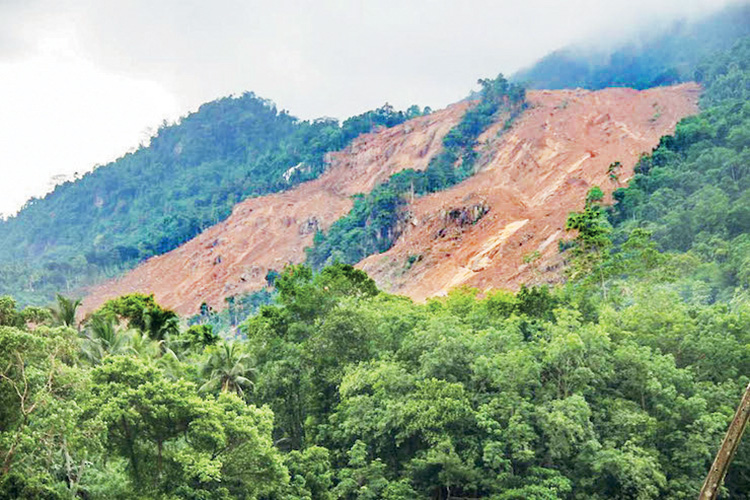
What Sri Lanka’s recent disasters tell us
Sri Lanka has always lived with the moods of the monsoon. For generations, people have grown used to seasonal rhythms of rain, wind and sunshine. Yet what the country has witnessed in recent months feels different. The storms have been stronger, the rainfall more intense, the destruction more widespread and the recovery more painful. The nation has been battered by floods, landslides and hurricane force winds that arrived with little warning and left thousands struggling to rebuild their lives. Scientists say this new pattern is not an accident of nature. It is a direct outcome of the world’s changing climate, which is heating the atmosphere and oceans and turning familiar weather cycles into something far more volatile.
To understand why Sri Lanka is experiencing such severe storms and flooding, it helps to begin with a simple idea. A warmer world holds more energy. When the atmosphere and ocean temperatures rise, they behave like an overheated engine. The monsoon winds strengthen. Rain clouds grow heavier. Sea levels climb. All these changes amplify the forces that produce extreme weather. What used to be occasional, manageable disasters are turning into regular and overwhelming events.
One of the clearest links between climate change and extreme weather is found in rising ocean temperatures. The Indian Ocean is warming faster than most other major bodies of water on the planet. This has serious consequences for Sri Lanka because the surrounding sea regulates the island’s climate. Warm oceans feed moisture into the atmosphere. This moisture then forms clouds that can trigger heavy downpours. When ocean temperatures climb beyond their normal range, the atmosphere becomes supercharged. Rain that once fell steadily over several days can now fall in a matter of hours. This explains why many parts of the country have witnessed sudden cloudbursts that turn roads into rivers and fields into lakes.
Warmer oceans also influence wind patterns. A heated sea surface disturbs air circulation, sometimes producing swirling systems that carry destructive winds and torrential rain. While full scale cyclones are less frequent in Sri Lanka than in parts of India or Bangladesh, the island is increasingly experiencing hybrid storms that bring cyclone like winds without being classified as named cyclones. These storms uproot trees, blow roofs off houses and knock down electricity lines, making post disaster life even harder for affected communities.
Another major factor behind Sri Lanka’s recent extreme weather is the shifting behaviour of the monsoon. For centuries, the island has relied on two monsoons that arrive at predictable times. Farmers, fishermen and traders built their lives around this rhythm. Climate change has disrupted this familiar pattern. The monsoons are becoming erratic. They may arrive later than usual or withdraw too early. In some years they bring too little rain, causing droughts. In other years they arrive with overwhelming intensity, bringing rain far beyond the land’s capacity to absorb. This unpredictability makes it difficult for people to prepare. It also increases the risk of disasters because infrastructure, agriculture and drainage systems were designed for a different climate.
In many regions of Sri Lanka, the land itself has become more vulnerable. Rising temperatures and unpredictable rainfall weaken soil structures. When long dry spells are followed by sudden downpours, the earth cannot hold together. Hillsides become unstable and landslides occur with devastating speed. Villages that once felt safe now face new threats as slopes collapse without warning. These disasters are not simply natural. They are intensified by human activities such as deforestation, poor land management and unplanned construction. Climate change acts as a catalyst, magnifying these risks and turning minor vulnerabilities into life threatening dangers.
The Sea level rise adds yet another layer of concern. The coasts of Sri Lanka are home to millions of people, as well as vital industries such as fishing, tourism and trade. Higher sea levels make coastal flooding far more common, especially when combined with storm surges. During recent storms, waves pushed much farther inland than usual, damaging homes, shops and fishing equipment. Saltwater intrusion also harms soil and freshwater supplies, threatening agriculture in coastal zones. With sea levels continuing to rise, these risks will only grow unless long term protective measures are put in place.
It is also important to recognise the human side of these disasters. Climate change is not only about shifting weather patterns. It is about the people who must confront the consequences. In the aftermath of the recent events, Sri Lankans have shown remarkable courage. Families have worked together to clear debris, rebuild houses, restore livelihoods and comfort those in distress. Yet the burden has not been evenly distributed. Low income households, informal settlements and rural communities often face the greatest hardships. Many of them live in areas more prone to flooding and landslides. They also have fewer resources to recover when disasters strike. Climate change therefore deepens existing inequalities, making vulnerable groups even more exposed.
Children are among the worst affected. Schools often close for days or weeks after floods, interrupting education and adding stress to families already struggling with upheaval. Health risks rise as stagnant water becomes a breeding ground for mosquito borne diseases. Malnutrition can worsen when livelihoods are disrupted and food prices increase. Elderly people face additional risks because they may have difficulty moving quickly during emergencies or accessing medical care after the disaster.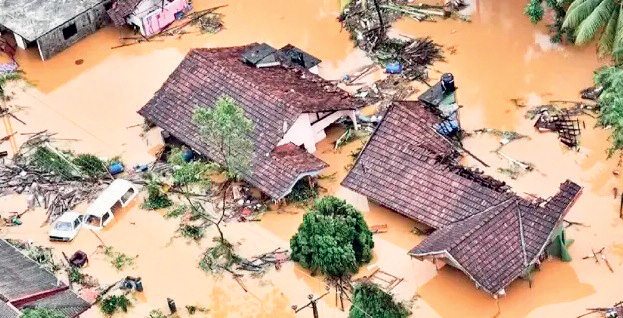
In cities, extreme weather strains essential services. Heavy rains overwhelm drainage systems, causing urban flooding that brings traffic to a halt and damages vehicles and businesses.
Hospitals face sudden influxes of patients. Water treatment plants struggle to maintain supply when rivers overflow or become contaminated. Power outages become common as strong winds damage transmission lines. These disruptions show how deeply interconnected human systems are with the natural environment. When the climate changes, every part of society feels the impact.
Despite the grim realities, there is reason for hope. Sri Lanka has a long history of resilience. Communities have rebuilt after countless storms, droughts and conflicts. Today the country has access to better technology, stronger scientific knowledge and more global support than ever before. What is needed is a clear commitment to prepare for the future rather than react only after disasters strike.
One of the most promising strategies is early warning systems. Accurate forecasts can save lives by giving people the time they need to move to safety. Sri Lanka has already improved its meteorological capabilities, but there is still room to strengthen local communication networks so that warnings reach everyone, including those in remote areas or without internet access. Community education is equally important. When people understand what climate change means for their region, they can make informed choices about housing, farming and water use.
Infrastructure must also evolve. Drainage systems in many towns need upgrading to handle more intense rainfall. Riverbanks require reinforcement to prevent flooding. New buildings, particularly in risk prone zones, must follow safety standards that take climate change into account rather than relying on outdated assumptions about weather patterns. At the same time, restoring natural ecosystems can offer powerful protection. Replanting mangroves, preserving wetlands and maintaining forest cover all help buffer the impact of floods, storms and landslides. Nature is one of the most effective defences against extreme weather when it is allowed to function properly.
On a broader level, Sri Lanka will benefit from global efforts to slow climate change. The island is a small emitter of greenhouse gases compared to many industrialised nations, yet it bears a heavy share of the consequences. International cooperation is essential to reduce harmful emissions, invest in renewable energy and support adaptation in vulnerable countries. Sri Lanka can also strengthen its energy security by expanding solar, wind and other sustainable sources, which reduce dependence on fossil fuels that contribute to climate change.
However, even as governments and scientists work on long term solutions, the experience of ordinary Sri Lankans during the recent storms offers an important lesson. Climate change is not a distant threat. It is happening now. It is felt in flooded living rooms, damaged paddy fields, broken bridges and displaced families. It reshapes the choices parents make for their children and the fears felt by those who live close to rivers or hillsides. It influences food prices, housing stability and health. It is a lived reality, not just an environmental problem.
At its heart, the story of Sri Lanka’s extreme weather is a story about people trying to protect their homes and loved ones. It shows how a global crisis can land with fierce intensity on a small island. But it also reveals the strength of human solidarity. Neighbours rescuing neighbours. Strangers offering food and shelter. Volunteers stepping into danger to help those trapped in rising waters. This spirit of care will be essential in the years ahead as the climate continues to warm and weather events become even more unpredictable.
There is no single solution that will shield Sri Lanka from every future storm. Yet there are many steps the country can take to reduce risk, strengthen communities and build resilience. These efforts will require resources, planning and political will. They will demand cooperation across regions, sectors and generations. Above all, they will require recognising that climate change is not someone else’s problem. It is a shared challenge that demands collective responsibility.
The recent disasters have served as a warning and a call to action. They have shown how quickly weather can turn violent and how deeply it can disrupt daily life. But they have also shown the urgency of preparing for a hotter and more unpredictable world. Sri Lanka has the knowledge and the capability to adapt. Its people have the determination. If these strengths are harnessed with foresight and compassion, the country can chart a safer path through the stormy decades ahead.
Climate change may be reshaping the monsoon, but it does not have to dictate Sri Lanka’s destiny. With the right choices, the island can remain not only a place of natural beauty but also a place of resilience, hope and human connection in the face of a changing planet.
(The writer is an environmentalist.)
by Vincent David ✍️
-
News4 days ago
Lunuwila tragedy not caused by those videoing Bell 212: SLAF
-

 News3 days ago
News3 days agoLevel III landslide early warning continue to be in force in the districts of Kandy, Kegalle, Kurunegala and Matale
-

 Latest News6 days ago
Latest News6 days agoLevel III landslide early warnings issued to the districts of Badulla, Kandy, Kegalle, Kurunegala, Matale and Nuwara-Eliya
-

 Features5 days ago
Features5 days agoDitwah: An unusual cyclone
-

 Latest News6 days ago
Latest News6 days agoUpdated Payment Instructions for Disaster Relief Contributions
-

 News1 day ago
News1 day agoCPC delegation meets JVP for talks on disaster response
-

 News1 day ago
News1 day agoA 6th Year Accolade: The Eternal Opulence of My Fair Lady
-

 Latest News7 days ago
Latest News7 days agoLandslide Early Warnings issued to the Districts of Badulla, Colombo, Gampaha, Kalutara, Kandy, Kegalle, Kurunegala, Matale, Moneragala, Nuwara Eliya and Ratnapura


